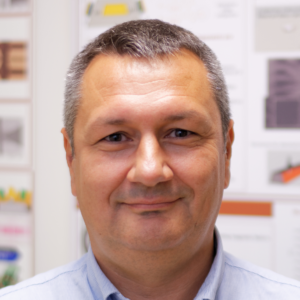Overview
The Magnetic Random Access Memories (MRAM) group develops advanced concepts in this emerging technology. The goal is to realize cells with improved thermal stability, lower power consumption and/or faster switching. Our research covers material stack deposition, nano-fabrication and electrical test evaluation, for applications as standalone memory and non-volatile logic and more recently in neuromorphic computing architectures.
Research directions
Perpendicular Anisotropy Materials
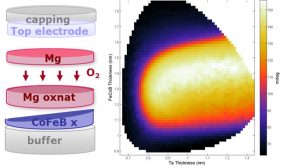
High energy barriers for spin transfer torque (STT) MRAM cells can be achieved with perpendicular anisotropy magnetic tunnel junctions. Solutions for high density MRAM cells to diameters below 20nm require continuous improvements in perpendicular surface anisotropy, while maintaining high TMR properties.
Perpendicular STT MRAM
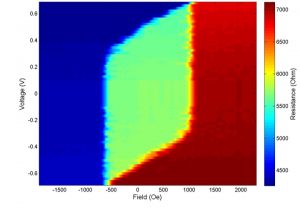
Evaluation of MRAM concepts requires simulation of expected reversal mechanisms and electrical characterization of individual cells. We aim at understanding dynamics of magnetization reversal and the expected impact of stack modifications to explore application specific optimizations.
Nanofabrication Challenges
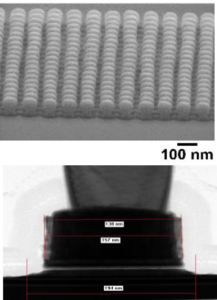
Innovation on dense MRAM using pre-patterned substrates, CMOS integration of multifunctional cells and sub-10nm lateral sizes. Tunnel junction nanofabrication in our platform is essential to evaluate MRAM concepts and performance.
Perpendicular Shape Anisotropy
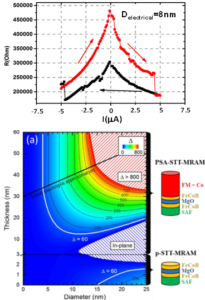
A solution for sub-10nm cell sizes uses high aspect ratios to generate perpendicular shape anisotropy providing scalable retention at the smallest cell sizes. Spin transfer torque switching is possible in these cells, where the reversal dynamics is now under study.
The team
Former members
Post-docs
- Andrey TIMOPHEEV (2014-2017)
- Van Dai NGUYEN (2016-2018)
- J. Ranier Roiz (2015-2016)
- Nikita Strelkov (2016-2019)
PhD
- Luc TILLIE (2015-2018)
- Nicolas PERRISSIN (2015-2018)
- Jyotirmoy CHATTERGEE (2014-2017)
- Hieu Tan NGUYEN (2013-2016)
- Antoine Chavent (2013-2015)
Process Engineers
- Jude GUELFFUCCI (2015-2017)
- Nathalie LAMARD (2016-2017)
- Guillaume LAVAITTE (2015-2016)
Projects
- Samsung SGMI (2014-2017)
- ANR Excalyb (2014-2017)
- Heumem (2015-2018)
- EU-FET Spice (2016-2019)
- EU Great (2016-2019)
- ERC Magical (2015-2020)
Partners
- CEA LETI, Grenoble, France
- Institut NEEL, Grenoble, France
- Crocus Technology, Grenoble, France
- Samsung, San Jose, USA
- Singulus AG, Kahl am Main, Germany
- Aarhus University, Aarhus, Denmark
- Radboud Universiteit, Neijmegen, Netherlands
Recent news
- CRYMCO – An ANR project (January 28th, 2021)

The goal of project CRYMCO is to optimize MRAM cell concepts for operation in cryogenic temperature environments. The project will explore applications for storage in conventional and quantum information processing. In the first case, ... - SpinSpike – An ANR project (January 19th, 2021)

SpinSpike stands for Spintronic Spiking Neurons. It is a 42-month-long ANR project (2021/2024). Spintronics has recently shown its promise for neuromorphic computing, but is lacking an essential ingredient of biological neural networks: spiking neurons. In this ... - Highlights of SPINTEC research in 2020 (December 10th, 2020)

The research highlights of SPINTEC over the year 2020 have been put together, and are available to download: https://www.spintec.fr/spintec-annual-booklets. This booklet contains the key facts of the lab over the period (contracts, new staff etc.), the ... - Post-doctoral position – Spintronic Spiking Neurons (December 07th, 2020)

In the frame of the French national ANR project SpinSpike, Spintec laboratory is opening a postdoctoral researcher position. The candidate will work in collaboration with UMPhy CNRS-Thales and Thales TRT. The objective is the realization ... - PhD defense – Memristive magnetic memory for spintronic synapses (December 07th, 2020)

On Thursday, December 17, 2020 at 13H30, Marco Mansueto will defend his PhD entitled: Memristive magnetic memory for spintronic synapses Video conference: https://grenoble-inp.zoom.us/j/96102161721 Abstract : In the context ...







